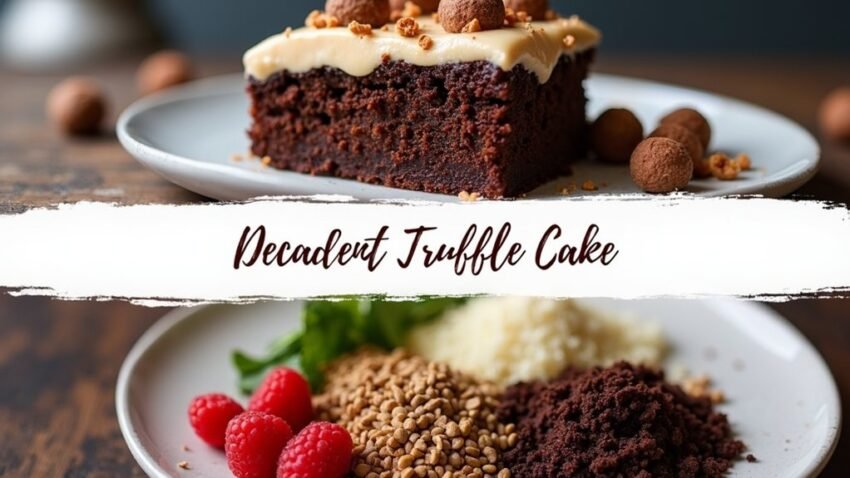Decadent Truffle Cake Recipe

Decadent Truffle Cake Recipe
When you think of indulgence, when you imagine a chocolate lover’s dream, the Decadent Truffle Cake comes to mind. This recipe not only showcases luxurious flavors but also demands your attention to detail in every step. You’ll uncover how the rich cake base and velvety frosting work in harmony, creating an experience that’s hard to resist. As you prepare to make this sumptuous dessert, consider what makes it truly special and why it deserves a place at your next gathering.
Key Takeaways
- Use high-quality chocolate (60% cocoa) for rich flavor and a luxurious truffle cake experience.
- Prepare a moist chocolate base, layered with velvety truffle frosting and a glossy glaze for optimal taste.
- Bake at 350°F initially, then reduce to 250°F for the perfect cake texture.
- Allow frosting to cool and thicken before pouring for a smooth, elegant finish.
- Serve the cake at room temperature to enhance its rich, decadent flavors.
History
While the exact origin of chocolate truffles remains a topic of debate, their history is rich and fascinating. Multiple claims exist regarding their creation:
-
Louis Dufour: Credited with inventing the first chocolate truffle on Christmas Day in 1895 in Chambray, France.
-
Georges Auguste Escoffier: His kitchen is mentioned as a possible origin site in the 1920s.
-
Patisserie Siravdin: Some sources suggest truffles originated in Paris around 1850 or in Switzerland.
The invention of ganache, a blend of cream and solid chocolate, played a vital role in developing chocolate truffles. Ganache emerged as a result of a mistake by Escoffier’s apprentice, which ultimately contributed to the creation of the rich filling that defines truffles today.
Key advancements in chocolate-making also shaped their evolution:
-
The cocoa press, invented in 1828, allowed for solid chocolate by removing cocoa butter.
-
Henri Nestlé’s creation of milk chocolate in 1879 made ganache more accessible.
Chocolate truffles were initially luxurious treats, but as their popularity grew, they became versatile confections with various flavors and textures.
The name “truffle” comes from their resemblance to the edible fungus, which adds to their allure and association with indulgence.
This rich history underscores the cultural significance of chocolate truffles in culinary traditions.
Recipe
Indulge in the rich and luxurious flavors of this decadent truffle cake, a perfect centerpiece for any celebration or a delightful treat for chocolate lovers. The cake combines a moist chocolate base with a velvety truffle frosting and is finished off with a glossy chocolate glaze. The cake remains moist for days, ensuring that each slice is just as delightful as the first.
Whether you’re baking for a special occasion or simply craving something sweet, this recipe is sure to impress with its irresistible combination of textures and flavors. The process may seem intricate, but with careful attention to detail and a little patience, you’ll create a stunning dessert that’s as pleasing to the eyes as it’s to the palate.
The truffle cake’s layers harmonize beautifully, making each bite a delightful experience. So gather your ingredients and prepare to initiate a chocolate journey that will leave everyone wanting more!
Final Thoughts
Concluding your truffle cake adventure, you’ll find that serving and storing this exquisite dessert is just as important as the baking itself. Here are some essential tips to keep in mind:
-
Serving Temperature: Serve your cake at room temperature for the best flavor.
-
Preparation: Remove it from the refrigerator 30-45 minutes before serving to let it warm up.
-
Storage: Keep leftovers in the refrigerator and enjoy them within five days to maintain freshness. Remember that the cake should be stored properly to prevent it from becoming dry and losing its creamy texture.
-
Decorating: Allow the frosting to set before adding any chocolate pieces, candies, or fresh raspberries.
-
Layering: Instead of baking multiple layers, consider cutting each layer in half to achieve the desired height.
Proper attention to these details improves your dessert experience.
Remember, the truffle cake should be a treat for both the eyes and the palate.
Regarding serving, take your time to present it beautifully, and don’t rush the storage process.
With these practices, you not only enhance the cake’s taste but also guarantee it remains a delightful indulgence for everyone.
Enjoy every moment of your truffle cake journey!
FAQ
Common Mistakes:
-
Wrong Chocolate: Always opt for high-quality baking chocolate with at least 60% cocoa for the best flavor. Using pure chocolate ensures that your truffles have the ideal texture and taste.
-
Chocolate-to-Cream Ratio: Maintain a 2:1 ratio of chocolate to cream for ideal truffle consistency.
-
Chopping Chocolate: Verify you chop chocolate into small pieces to promote even melting.
-
Heating Cream: Bring cream to a simmer, then cool slightly before pouring it over chocolate.
-
Serving Temperature: Serve truffles at room temperature for a melt-in-your-mouth experience.
Baking Tips:
-
Temperature: Bake initially at 350°F, then reduce to 250°F to achieve the right texture.
-
Cooling: Allow the cake to cool with the oven door cracked to prevent sudden temperature changes.
Assembly Tips:
-
Leveling: Trim the top of the cake with a serrated knife for a flat surface.
-
Frosting: Let the truffle frosting cool and thicken before pouring it over the cake for a smooth finish.



